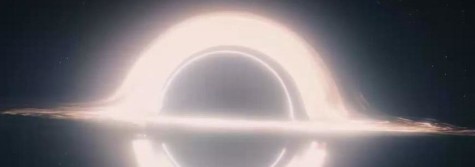Cosmology is timeless, perhaps literally—as this post argued on January 23, 2015.

In the 1992 documentary A Brief History of Time, Stephen Hawking describes what we would see if we were observing an astronaut nearing a black hole’s event horizon—the barrier beyond which gravitation is so great that not even light can escape. He invites us to imagine that the astronaut is wearing a watch, and that the second hand is ticking toward 12:00. As the astronaut gets closer to the event horizon, the motion of the second hand will appear to us to be slowing down. The closer the astronaut gets to the event horizon, the slower the motion of the hand, from our perspective. “Each second on the watch would appear to take longer and longer,” Hawking says, “until the last second before midnight would take forever.”
Then the documentary reverses the point of view and explores what the astronaut would be experiencing. That poor sap has a perspective, too. And that’s where things get weird. (Well, weirder.)
In a previous post I wrote about the fictional black hole in the movie Interstellar. Under the guidance of director Christopher Nolan, the film combines CGI artistry with actual general relativity to depict the black hole as realistically as possible. (The movie received the 2015 Academy Award for Visual Effects.) As a result, audiences can see how the overpowering gravitational pull of a supermassive black hole would distort the light paths of background objects—including those that, from where the moviegoer sits, are on the opposite side of the black hole. Those sources of light, usually out of sight, would come into view.
That much I understood when I first saw images of the movie’s black hole. What I learned only later was that among the opposite-side sources of light coming into view would have to be the far portion of the accretion disk—the Saturn’s-ring-like collection of glowing gas that the black hole has accumulated. I looked at the image of Interstellar‘s black hole again, and sure enough, there it was: the other side of the accretion disk, rising up from behind the black hole, pulled up like the collar of an overcoat. As I wrote at the time, “Of course!”
 This pattern of personal discovery repeated itself when I finally got around to watching director Errol Morris’s A Brief History of Time. That general relativity predicts (and experiments have shown) that for an outside observer, time will appear to pass more slowly in an area of greater gravitation—for instance, on an astronaut’s wristwatch in the immediate vicinity of a black hole? Knew it. That for the outside observer, the astronaut’s watch will never reach midnight (and the radiation of the frozen image of both astronaut and watch will lose its energy until it fades from view)? Knew that, too. That, conversely, time will continue to pass normally from the astronaut’s point of view, the second hand stepping in uniform ticks until, at the stroke of midnight, the astronaut crosses the event horizon? Yawn.
This pattern of personal discovery repeated itself when I finally got around to watching director Errol Morris’s A Brief History of Time. That general relativity predicts (and experiments have shown) that for an outside observer, time will appear to pass more slowly in an area of greater gravitation—for instance, on an astronaut’s wristwatch in the immediate vicinity of a black hole? Knew it. That for the outside observer, the astronaut’s watch will never reach midnight (and the radiation of the frozen image of both astronaut and watch will lose its energy until it fades from view)? Knew that, too. That, conversely, time will continue to pass normally from the astronaut’s point of view, the second hand stepping in uniform ticks until, at the stroke of midnight, the astronaut crosses the event horizon? Yawn.
But the documentary didn’t stop there.
Remaining in the point of view of the astronaut, Brief History took the reciprocal observations one insight further. Just as the outside observer would see the astronaut’s time as going slower and slower, so the astronaut would see the time in the rest of the universe going faster and faster. The closer the astronaut gets to the accretion disk, the faster the passage of time. At the moment the outside observer sees the astronaut’s time come to a halt, the astronaut would witness the entire future of the universe.
Of course!
Yes, I know: the entire future of the universe.
Still: Of course!
Now that’s a combination of CGI and general relativity I’d pay to see. Mr. Nolan, the entire future of the universe is ready for its close-up.
* * *

If the astronaut sees the entire future of the universe in a short finite time, does he or she get burned to a crisp by the intense energy? It seems like entire stars, even galaxies, will illuminate him or her with billions of years of their output in a minute fraction of a second. Of course, most of them are very far away and likely moving even farther. Still, if the black hole has a companion star, might it be close enough to induce crispness?
This is the sort of thing I worry about.
Ha. Thank you. No idea what the answer is. You’ll just have to keep on worrying on behalf of the rest of us.